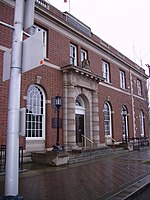St. Andrew's Episcopal Church (Port Angeles, Washington)

St. Andrew's Episcopal Church, also known as the Salvation Army Citidel Corps and now hosting the Salvation Army Corps Community Center, is a historic building located at 206 South Peabody Street, in Port Angeles, Washington. Originally a church, the structure was built in 1905 in Gothic Revival style. Between 1905 and 1914 a free standing parish hall was constructed south of the chapel. St. Andrew's became an official parish in 1946. In 1966, due to the parish having outgrown the small chapel, a new church was built about 1 mile (1.6 km) to the south, on East Park Avenue, and the building was sold to the Salvation Army, which still uses it today as its Corps Community Center.
Excerpt from the Wikipedia article St. Andrew's Episcopal Church (Port Angeles, Washington) (License: CC BY-SA 3.0, Authors, Images).St. Andrew's Episcopal Church (Port Angeles, Washington)
East 2nd Street,
Geographical coordinates (GPS) Address Nearby Places Show on map
Geographical coordinates (GPS)
| Latitude | Longitude |
|---|---|
| N 48.11586 ° | E -123.42933 ° |
Address
East 2nd Street 370
98362
Washington, United States
Open on Google Maps









